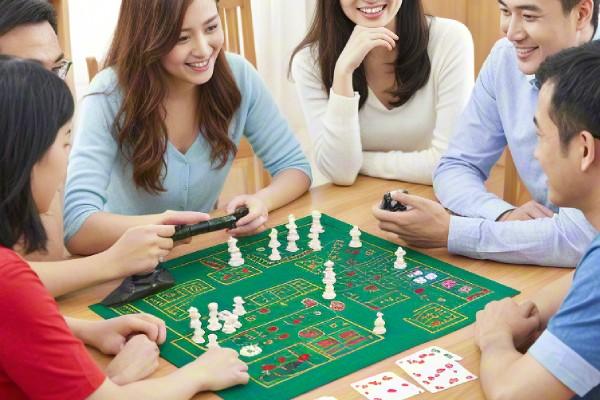Best board games for family game night
Best Board Games for Family Game Night
Family game night is a great way to bond, laugh, and create lasting memories. Whether your family enjoys strategic challenges, lighthearted fun, or a mix of both, there’s a board game that fits every vibe. But with so many options out there, it can be tricky to know where to start. Here’s a list of some of the best board games that cater to various ages, interests, and skill levels, making them perfect for family game night.

1. Codenames
Age Group: 14+ | Players: 4-8+
Codenames is a fast-paced word game that involves two teams trying to guess the identities of secret agents based on one-word clues. Each team is led by a spymaster who gives cryptic clues to help their team guess the words on the board. The challenge is to provide clues that are both clever and efficient, all while avoiding the "assassin" word that ends the game instantly. The game’s simple rules and intense strategy make it a hit for families with older kids or teens.
Why it's great for families: It’s a fun way to challenge your word association skills, and the interaction between team members leads to plenty of laughs and “aha!” moments.
2. Ticket to Ride
Age Group: 8+ | Players: 2-5
Ticket to Ride is a classic board game where players build train routes across the map. Players collect cards to claim railroad tracks that connect cities, with the ultimate goal of completing secret destination cards for points. It’s easy to learn and plays at a good pace, so even younger kids can get involved. The game scales well with different player counts, making it a flexible option for any family size.
Why it's great for families: The rules are straightforward, and it has just the right balance of strategy and luck to keep everyone engaged. Plus, the theme of train travel and adventure appeals to all ages.
3. Catan
Age Group: 10+ | Players: 3-4
Catan (formerly The Settlers of Catan) is a strategy game where players compete to settle an island, gathering resources like wood, brick, and wheat to build roads, settlements, and cities. The key to success lies in resource management, trading, and strategic expansion. While the gameplay can get competitive, it’s also a great way to practice negotiation and strategic thinking.
Why it's great for families: Catan fosters social interaction, whether it’s trading with other players or deciding the best spot to build your next settlement. It’s a great way to build problem-solving skills in a fun, interactive way.
4. Dixit
Age Group: 8+ | Players: 3-6
In Dixit, players use beautiful, abstract illustrations on cards to tell a story. One player gives a clue based on one of their cards, and everyone else picks a card from their hand that matches the clue. The goal is to be as creative as possible, but not so obscure that no one guesses your card. The game encourages storytelling, imagination, and thinking outside the box.
Why it's great for families: It’s a visually stunning game that sparks creativity and imagination. Plus, it’s suitable for players of all ages, making it an excellent choice for families with both younger and older members.
5. Azul
Age Group: 8+ | Players: 2-4
Azul is a tile-laying game where players take turns selecting colorful tiles to create patterns on their individual boards. The aim is to fill rows and columns with matching tiles, earning points for completing specific patterns. The game is easy to learn but offers a surprising depth of strategy as players need to consider both their moves and the moves of others.
Why it's great for families: It’s visually appealing and has simple rules, but the strategy keeps things interesting for all players. It’s also a short game, making it perfect for quick, competitive sessions.
6. Pandemic
Age Group: 8+ | Players: 2-4
Pandemic is a cooperative board game where players work together as a team of specialists trying to stop the spread of four diseases threatening the world. You’ll need to use your unique roles and cooperate to collect cards, treat infected areas, and ultimately discover cures. What sets Pandemic apart is the need for teamwork, as everyone works toward the common goal of saving the world.
Why it's great for families: The cooperative aspect fosters communication and teamwork. Plus, it’s an excellent opportunity for families to bond while tackling challenges together, rather than competing against one another.
7. Splendor
Age Group: 10+ | Players: 2-4
In Splendor, players take on the role of wealthy merchants during the Renaissance, collecting valuable gems to purchase development cards. These cards grant points and can help you earn even more gems. The game is quick, but it requires strategic thinking as you try to build your wealth and outpace your opponents.
Why it's great for families: The rules are easy to pick up, but the strategic decisions create a tense yet fun experience. The game can be played in about 30 minutes, making it perfect for quick rounds in between other activities.
8. Sushi Go!
Age Group: 8+ | Players: 2-5
Sushi Go! is a fast and fun card game where players try to create the best meal by collecting sushi dishes. The cards are passed around, and each player picks one card to keep before passing the rest to the next player. The goal is to collect the most valuable combinations of sushi, from sashimi to dumplings, while avoiding too many wasabi cards.
Why it's great for families: The gameplay is quick, easy to understand, and perfect for a short but fun family game night. Plus, the colorful sushi illustrations are adorable and engaging for all ages.
9. The Game of Life
Age Group: 8+ | Players: 2-6
In The Game of Life, players navigate through life’s major milestones—from education to career choices, marriage, children, and retirement. The game combines chance and strategy, with players making decisions that impact their journey. It’s a nostalgic favorite that families can enjoy together while reflecting on the ups and downs of life.
Why it's great for families: It’s lighthearted and provides moments of humor and learning. The simple concept of “life choices” makes it accessible for younger players, and older players can add their own strategic flair to the experience.
10. Apples to Apples
Age Group: 12+ | Players: 4-10
Apples to Apples is a hilarious party game where players match nouns to adjectives. One player draws a card with an adjective (e.g., "Wicked"), and everyone else submits a noun (e.g., "Harry Potter") that they think best fits the adjective. The judge selects their favorite combination, and the player with the winning card gets a point. The goal is to get the most points by being creative and witty.
Why it's great for families: It’s simple, fun, and perfect for larger groups. The humor is broad enough for kids and adults to enjoy, making it an ideal game for multi-generational family fun.
Conclusion
Whether you're seeking strategy, creativity, or just a good laugh, these board games are all fantastic options to bring the family together for game night. They encourage teamwork, friendly competition, and plenty of fun, ensuring your weekend game nights are filled with laughter and memorable moments. So, gather around the table, pick your game, and let the fun begin!
This article provides a diverse selection of board games that are great for families, offering something for every type of player and family dynamic. If you'd like more suggestions or specific recommendations, feel free to ask!
Best Board Games for Kids Aged 4 and Up
Introducing children to board games is not only a great way to have fun together but also an opportunity to teach them valuable skills such as critical thinking, patience, and sportsmanship. Board games designed for kids aged 4 and up are perfect for fostering creativity, learning new concepts, and spending quality family time. Here’s a list of the best board games that are both fun and educational for children in this age group.
1. Candy Land
Age Group: 3+ | Players: 2-4
A timeless classic, Candy Land is a simple race-to-the-finish game that is perfect for young kids. Players draw cards that tell them where to move on the colorful board, navigating through candy-themed locations. The first player to reach King Kandy’s castle wins. The game’s simplicity and bright, cheerful design make it an excellent choice for kids just starting to play board games.
Why it’s great for kids: It’s easy to understand, helps teach color recognition, and provides practice with turn-taking and patience. There’s no need for reading, so even younger kids can play and enjoy it.
2. Memory
Age Group: 3+ | Players: 2-6
Memory is a classic matching game that challenges kids to remember where pairs of cards are located. Players take turns flipping over two cards at a time, trying to find matching pairs. It’s a fun way to enhance memory skills, concentration, and attention to detail while enjoying some friendly competition.
Why it’s great for kids: It helps develop memory and cognitive skills in a fun and interactive way. The game can be played with varying difficulty levels by changing the number of cards or using different themes (animals, numbers, etc.).
3. The Sneaky, Snacky Squirrel Game
Age Group: 3+ | Players: 2-4
In The Sneaky, Snacky Squirrel Game, players help a squirrel gather colored acorns and place them into their tree stumps. The game is played with a fun, squirrel-shaped squeezer tool that adds a little extra excitement as kids grab and place their acorns. The goal is to be the first to collect all of your acorns.
Why it’s great for kids: The game promotes fine motor skills as kids use the squirrel squeezer and helps teach color recognition, turn-taking, and simple strategy. It’s an engaging and interactive game that keeps little ones entertained.
4. Hi Ho! Cherry-O
Age Group: 3+ | Players: 2-4
Hi Ho! Cherry-O is a simple counting game where players work to pick fruit from their tree and fill their basket. Players spin the spinner to see how many pieces of fruit they can collect, but they must watch out for situations like spilling the fruit or losing it to the bird! The first player to fill their basket wins.
Why it’s great for kids: It teaches counting, basic math skills, and the concept of taking turns. It’s a great way to reinforce number recognition and simple decision-making in a playful, low-pressure environment.
5. Zingo!
Age Group: 4+ | Players: 2-6
Zingo! is a fun, fast-paced game that combines elements of bingo and matching. Players try to match pictures on their Zingo cards to tiles drawn from the Zingo dispenser. The first player to fill their card with the correct images wins. It’s a great game for teaching word and picture recognition, as well as concentration and quick thinking.
Why it’s great for kids: It’s fantastic for reinforcing early literacy and matching skills. The game also helps improve hand-eye coordination and speeds up visual processing abilities. Plus, the excitement of the Zingo dispenser adds a thrilling twist!
6. Busytown
Age Group: 4+ | Players: 2-4
Busytown is a cooperative board game based on Richard Scarry’s popular book series. Players work together to complete various tasks in Busytown, like delivering groceries or fixing a car, by rolling the dice and moving along the board. The goal is to work together to finish tasks before the time runs out.
Why it’s great for kids: This game encourages cooperation and teamwork, as there’s no one "winner" but a collective goal to accomplish. It helps children develop social skills and a sense of shared responsibility, and it’s great for teaching basic strategy and problem-solving.
7. Duck Duck Dance
Age Group: 4+ | Players: 2-4
In Duck Duck Dance, players move around the board in a whimsical game that involves silly dancing and funny actions. As players roll the dice and move, they’ll land on spaces that ask them to perform specific actions like "quack like a duck" or "dance in a circle." It’s a fantastic way to get kids moving while having fun.
Why it’s great for kids: It’s a fun and active game that helps kids build gross motor skills and encourages physical activity. The silly, non-competitive nature of the game makes it ideal for younger kids who may not yet fully grasp complex rules or competition.
8. First Orchard
Age Group: 3+ | Players: 2-4
First Orchard is a cooperative game where players work together to harvest fruit from the orchard before the raven reaches the trees. The game is simple enough for young children to understand but still encourages teamwork, as players take turns rolling a die to move and collect fruit.
Why it’s great for kids: It introduces kids to the concept of cooperative play, where everyone wins or loses together. It also helps reinforce color recognition and counting in a fun and low-stress environment.
9. Grape Escape
Age Group: 4+ | Players: 2-4
Grape Escape is a fun and adventurous game where players take on the role of grapes trying to escape from the kitchen. The board is filled with action spaces like “bounce” and “wiggle,” and players must move along the path, avoiding traps and collecting pieces of fruit along the way.
Why it’s great for kids: This game incorporates fun movement and randomness with dice rolls, which keeps it exciting and unpredictable. It’s great for building a child’s ability to handle chance, strategy, and decision-making in a playful way.
10. Robot Turtles
Age Group: 4+ | Players: 2-4
Robot Turtles is a coding game for kids where they control robotic turtles by playing cards that represent different actions. The goal is to navigate their turtles through an obstacle-filled board to reach a jewel. It’s designed to introduce young children to the basic concepts of programming, such as sequencing, debugging, and logic.
Why it’s great for kids: Robot Turtles is an excellent introduction to STEM concepts, especially coding. The game is simple enough for young children but still introduces them to fundamental coding principles in an engaging and tangible way.
Conclusion
Board games for kids aged 4 and up are not only a great way to entertain, but they also provide opportunities for learning, development, and social interaction. From games that enhance memory and counting to those that foster teamwork and critical thinking, there’s a wide variety of options to suit different interests and developmental stages. Whether you’re looking for something cooperative, educational, or just plain fun, these games are sure to create lasting memories and spark joy in your child’s heart.
This list offers a range of games that balance fun with educational benefits, making them ideal for families with young children. If you need more suggestions or specific recommendations based on your child’s interests, feel free to reach out!









